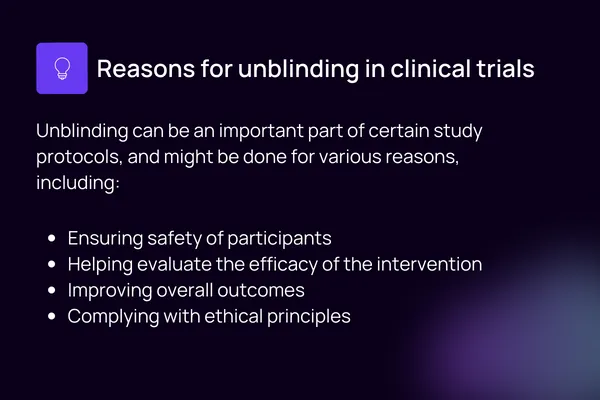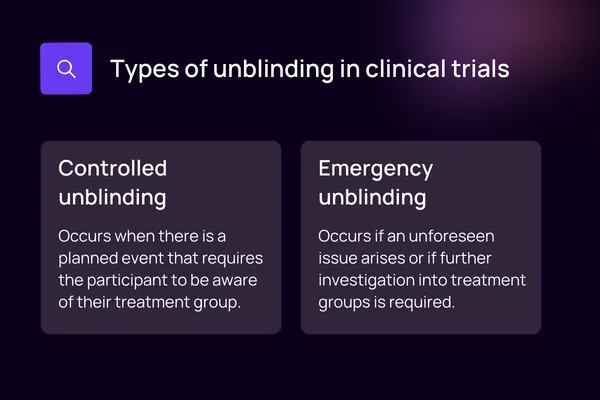Your session is about to expire
Clinical Trial Basics: Unblinding in Clinical Trials
What is unblinding in clinical trials?
Unblinding in clinical trials is a process by which individuals or groups become aware of (are “unblinded” to) the treatment(s) they or other participants have received. In a blind study, participants are not told whether they are receiving the investigational medical product, standard treatment, or placebo. In other words, they are “blinded.” Unblinding is thus the process of removing this blinding.

Importance of unblinding
In some cases, it can be difficult to interpret trial results accurately and make informed decisions without unblinding. Unblinding can thus allow stakeholders and researchers to assess outcomes and trial results more thoroughly by providing more transparent insights into how the investigational treatment performed.[1] In other cases, it may be important for the participants to know which treatment they received at the end of the study. However, participants are not always told this information.
Reasons for unblinding in clinical trials
Unblinding can be an important part of certain study protocols, and might be done for various reasons, including:
- Ensuring safety of participants
- Helping evaluate the efficacy of the intervention
- Improving overall outcomes
- Complying with ethical principles [1]
In many cases, unblinding can be beneficial or necessary, either for proper analysis or for making informed clinical decisions.

Challenges that can arise during unblinding
There are potential ethical implications of unblinding, as unblinding could introduce bias in the results by influencing the behavior of participants or the clinical decisions of researchers. For example, if participants know which treatment they are receiving, that knowledge could influence their subsequent responses or behavior throughout the course of the trial due to their expectation or perception about its effectiveness, possibly in comparison to alternative therapies being tested or to no therapy/placebo.
In addition, there are logistical challenges surrounding how best to ensure proper unblinding (and also blinding, for that matter) during clinical studies, such that any biases associated with knowledge about treatment assignments do not influence results.
As such, it is important to consider both intended and unintended consequences when deciding whether unblinding should take place as part of a clinical trial. Such issues should be addressed prior to beginning the trial and included explicitly in the protocol.
Unblinding plan in clinical trials
When planned as part of a study, a detailed procedure for performing the controlled unblinding will be included in the protocol. In some cases, unblinding is not planned but needs to be done in an emergency fashion, for example to enable the clinician to make a sound clinical decision for a participant who experiences a severe adverse reaction.[1] In the next section, we will explain the difference between the two main types of unblinding in clinical trials; controlled unblinding and emergency unblinding.
Types of unblinding: Controlled vs emergency unblinding
Unblinding can be a complicated and sensitive process, and should only happen under specific circumstances. These circumstances, along with unblinding procedures, should be clearly defined before the trial is started. Generally, two types of unblinding exist: controlled and emergency.

Controlled unblinding occurs when there is a planned event that requires the participant to be aware of their allotted treatment group. This could include adjustments to the protocol or changes in how data are collected. In such cases, it is necessary for participants to know which group they belong to so that the experiment can proceed with integrity.
Emergency unblinding is different from controlled unblinding in that it only occurs if an unforeseen risk or medical issue arises while the trial is in progress. It may also be required if data analysis reveals unexpected results that require further investigation into individual treatment groups. In either case, emergency unblinding typically involves revealing each participant’s assigned group and allowing them access to additional medical care or safety-related information pertaining specifically to their individual needs or those of their treatment group.
It is important for clinical trial sponsors to understand the differences between controlled and emergency unblinding, as well as the importance of safeguarding patient confidentiality at all times during these processes. Doing so not only ensures compliance with regulatory frameworks but also helps create trust among participants and stakeholders alike.
Unblinding for reporting to health authorities & ethics committees
Both the FDA and EMA have regulations for unblinding data when reporting serious adverse events (SAE) or serious adverse reactions (SAR). For more information on which circumstances require that these reports contain unblinded data, please refer to the cited article.[2]
There is also a third type of unblinding; that which occurs by accident.
Accidental unblinding: How can we prevent unwanted unblinding in clinical trials?
Accidental unblinding of clinical trial participants is a major issue in clinical research. This occurs when researchers or medical staff unintentionally reveal to participants which treatment they are receiving, either through their behavior or language. Unblinding can cause damage to the credibility of the study results, and may even result in harm or injury to the participants if incorrect treatments are administered.
To prevent accidental unblinding, there should be strict protocols established for all staff involved in administering treatments and following up with patients during trials. All forms of communication should be monitored and reviewed regularly to ensure that no participant has inadvertently been informed about which treatment they are receiving. Furthermore, all personnel should be educated on the importance of maintaining blinding throughout the course of a blinded trial. Clear guidelines should be put in place that outline how any breaches in blinding protocols can be avoided, or resolved quickly and efficiently if they do occur, for example by notifying senior management as soon as possible so corrective action can be taken.
Finally, it is essential that confidentiality agreements between parties involved in a trial are honored and strictly adhered to at all times so that no information is revealed - intentionally or unintentionally - about a participant’s assigned treatment group.
In conclusion, explicit steps should be taken to protect against and prevent accidental unblinding during clinical trials. This requires clear protocols for personnel handling treatments, regular monitoring of communication methods, education on why maintaining blinding is necessary, and swift resolution should accidental unblinding occur.
Conclusion
Unblinding in clinical trials is an aspect that requires careful consideration and management, both in trial design/planning and during the trial. There are two main situations in which unblinding would be conducted intentionally - controlled and emergency unblinding. These occur under different circumstances, but both must be implemented with caution to preserve the integrity of the trial and the confidentiality of private patient data. Circumstances warranting unblinding and unblinding protocols should be established before the trial begins.
Accidental unblinding can introduce bias and compromise the validity of the study results. To prevent accidental unblinding, rigorous protocols, robust masking techniques, and strict adherence to blinding procedures are essential. Additionally, effective training and communication among study personnel, investigators, and participants can minimize the risk of unintentional unblinding.
References
[1] https://toolbox.eupati.eu/resources/within-trial-decisions-unblinding-and-termination/